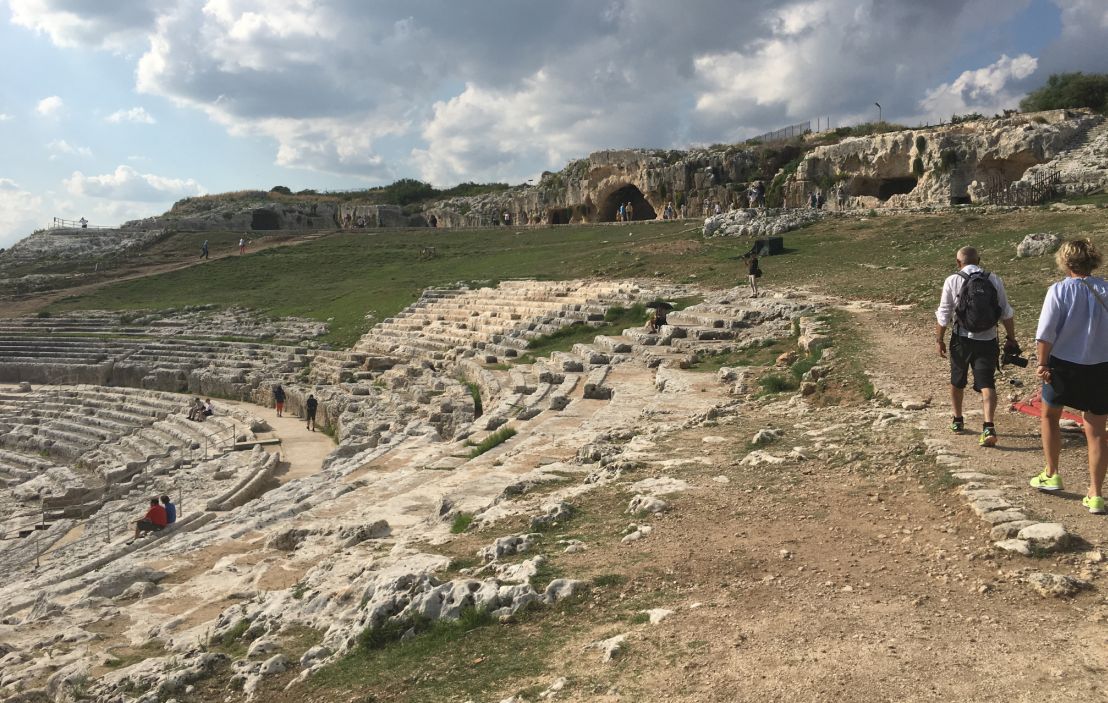
6 days in Sicily-09/24 - 09/29/2017
Day 4-Neapolis Archaeological Park of Siracusa, Syracuse-09/27/2017
| Breakfast | Roman Theater/Catania | Food market/Apollo Temple | Duomo Square | Archaeological Park | Greek & Roman Theater |
Greek Theater
Syracuse was the most important city of Magna Graecia. It defeated the mighty Athens in 413 and was home to many a great Greek, including the inimitable Archimedes. At the height of its economic, political and military powers, the city had a population of 300,000 and, according to Cicero, was “the greatest Greek city and the most beautiful of them all”. Syracuse's influence and status as one of the most important commercial and cultural centers in the Mediterranean. With such wealth and fame, it was only fitting that Syracuse should have one of the most impressive theatres in the Greek world.

The Greek theatre of Syracuse lies on the south slopes of the Temenite hill, overlooking the modern city of Syracuse . It was first built in the 5th century BC, rebuilt in the 3rd century BC and renovated again in the Roman period.

The Archaeological Park, along with the entire city of Siracusa, were designated as UNESCO World Heritage Site in 2005.

As one of the most impressive and largest theaters ever constructed in the Greek world, its fifty-nine rows of seating could hold as many as 15,000 spectators.
The Romans reduced the rows of seats to 46 to have a larger stage area for bloody gladiatorial games. The seats and the auditorium are remain largely untouched.

The Greek theater is still used for open-air performances staged by the Fondazione Istituto Nazionale del Dramma Antico (National Institute of Ancient Drama), a national organization for the promotion of classical drama. Plays are performed in May and June, as well as concerts throughout the summer months. To attend a performance and watching the sun set as it appears to fall like a stone behind the stage before disappearing into the Ionian Sea is unforgettable.

Unlike the Romans, the Greeks used their theater for a more civilized form of entertainment. Plays, tragedies, circus performances were performed here to entertain the masses. It was also used for public meetings and gatherings. The theater was cut directly out of the limestone rock with the seats facing the sea providing for a wonderful view, especially from the top tiers of the theater.


The stage

Closer look at the stage

The theater is beautifully preserved considering it was built in the 5th century.

|
|
|
The mills was constructed in the 16th century, when the fountains of the Greek era were reactivated.

We are now walking above the theatre.

During the Byzantine era, graves were carved into the rock wall that supported the upper portico (which ran along the edge of the of the theater). These graves were conjured in an arcosolium style, meaning they consisted of an arched recess or niche into which the deceased could be placed. Their presence provided the name the road that runs along the terrace once occupied by the portico, the Via dei Sepolcri (“Street of the Tombs”).

All these tombs remain today, but centuries of plundering have resulted in only
the cavities themselves remaining, completely bare and in more than one case
bizarrely eroded by centuries of severe weather.


One of the most romantic points of this rock wall is the so-called Grotta del Ninfeo, or “Grotto of the Nymph,"
The Grotto of the Nymph, is an artificial cave carved into the limestone, built to honor the muses.
An aqueduct carried water into the grotto from miles away and both the cave and niches in the cliff were once embellished with statues of religious images.

On the left side of the Grotto of the Nymph there is a small street of tombs dating from the Byzantine period.

The water channel, part of the Galermi aqueduct, dates back to the Greek era and was restored in the mid-16th century to feed the watermills (small house posted above).
Today, of course, the ancient fountain is merely a decorative element.

We are standing at the highest point over looking at the Ionian Sea in the horizon, below is the Greek theater.
Breathtaking view from here.
 |
|
Path leading to the center stage.

We are now on the stage at the lowest point of the theater overlooking the tombs and grotto high above.

From the theater you can also see the freeway...
Roman Theater
The Roman theatre was built in the late phase of the Roman period in the 3rd Century A.D. and had a huge stage. Presumably, the stage of the neighboring Greek theatre had become too small for the elaborate gladiatorial combat.
Unlike the Greek theatere, the Roman theater is overgrown, covered in flowers and often overlooked by visitors.

The theatre is large and measures about 140 meters by 119 meters (external dimensions) with the lower level having been dug out. All of the upper sections of the theater that were constructed of stone were dismantled in the 16th century by the Spanish for use on the island of Ortygia.

This is the view of the Roman theater from the south side. At the center of the arena you can see a rectangular pit, which was originally covered.
Almost nothing of the superstructure, which was built from masonry, survives.
 |
 |
The Romans use of their Amphitheaters was much different than that of the Greeks. Like the famous arena in Verona and the Coliseum in Rome, the amphitheater here in Syracuse was used primarily for violent Gladiator contests and fights with wild animals.

An underground passage ran from this pit to the entrance at the southern end of the amphitheater. This pit and passage were necessary for machinery used during the shows.
 |
 |
This conclude our visit here...

Walking toward the exit of the park...
Next...Day 5-Valley of the temples, Agrigento